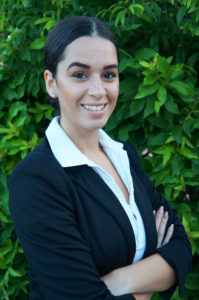Recently we spoke with Taylor Shields, sixth grade English and Social Studies teacher and Partnership Team Lead at George Washington Carver Middle School, to learn more about how she prepares her students for success. Get an inside look at Taylor’s teaching style in this PROfile.

Taylor Shields knew she wanted a teaching career in South LA after moving from New York.
What kind of planning and facilitation do you support as a Team Lead?
As a Team Lead at Carver I’ve had the privilege of working with the school’s administrative team and Partnership team to support the needs of our teachers. My role has allowed me to use teacher feedback to best facilitate collaborative planning time and support discussions that create change around equitable student outcomes. This year, our collaborative planning time and lesson cycles are taking a leap toward using student data to drive our instruction.This includes year-long scope and sequences; backward planning models; and providing students with the skills and strategies necessary to access a complex text and respond to it via a grade-level, standards-aligned writing prompt. Most importantly, I get to be part of a team of courageous voices that speak up for the experts at our school, teachers and students alike.
How do you cultivate relationships with students and why is it important to do so?
Relationship-building has always been at the forefront of conversation when talking about student success in my classroom. I take time to know the little things about our students. I do this through various ways, such as communication with parents via phone app; student surveys; showing students the human side of teaching; and cultivating real life conversations. So when it comes to my students I know who is at home, who their siblings are, their favorite movie, and I bring that to our classroom discussions. Students want to know that you care and can sense when it’s genuine. My biggest success in cultivating relationships has always been holding my students to high expectations. I convey positive reinforcement messages about them going to and completing college, and my lessons and their work reflects that, too. I tell them, “We have progress to make, but if you want it, you will achieve it and I am here to challenge you above and beyond that goal.”
Your student achievement results increased from 2017-18 to 2018-19, to what do you contribute that success?
My student achievement results are a collection of components. As a teacher, I am continuously reflecting on my practice. When I first started teaching, I assumed my students would do well because we had strong relationships, but it was so much more than that. Students’ results improved because they took ownership of their learning. For example, by the end of the 2018-19 school year my students met or exceeded standards in SBAC ELA by a 17 percentage point growth. In that same year, I was also able to decrease the percentage of students not meeting or exceeding standards by more than 50%. In addition, 90% of my students met their growth target in Lexile. I also improved my practice by providing intentional feedback with actionable steps and including parents in the academic and social progress of their children. The best part was the eagerness and excitement of students and parents to take on that challenge.
Going into this school year, what do you hope for your students?
From the moment I started teaching I always said I wanted students to run my classroom, and that is still a hope I have for my students. It’s not just about empowering our students. It’s also about giving them leadership opportunities so they can claim their own education. I like for my students to inquire about their lessons and see where it takes them. This encourages my students to find different ways to succeed in our English and history classes, and prepares them for life after graduation. My hope is to see them embrace their strength and knowledge, not because someone told them to, but because they took ownership of it.
How has the Partnership supported your development?
My move from New York to California was difficult because I kept hitting so many barriers along the way. I knew I wanted to continue my teaching career in South LA. When I reached out to the Partnership, I was instantly greeted with the respect I knew I deserved as a teacher. Throughout my journey in South LA, the Partnership has gone above and beyond in support of my leadership and craft as a teacher. I have been offered many opportunities in and out of my school site to build my teaching capacity. Some of these opportunities include attending the National Standards Institute; working alongside the restorative justice coach to improve our practices across schools; and developing my experience as a Team Lead. I’m grateful to have been embraced by our network of strong-willed teachers and coaches who truly believe in our students.
What do you do when you are not teaching?
When I am not teaching I am either at the beach, binge-watching TV, or traveling back home to New York to visit my biggest source of inspiration, my family.
